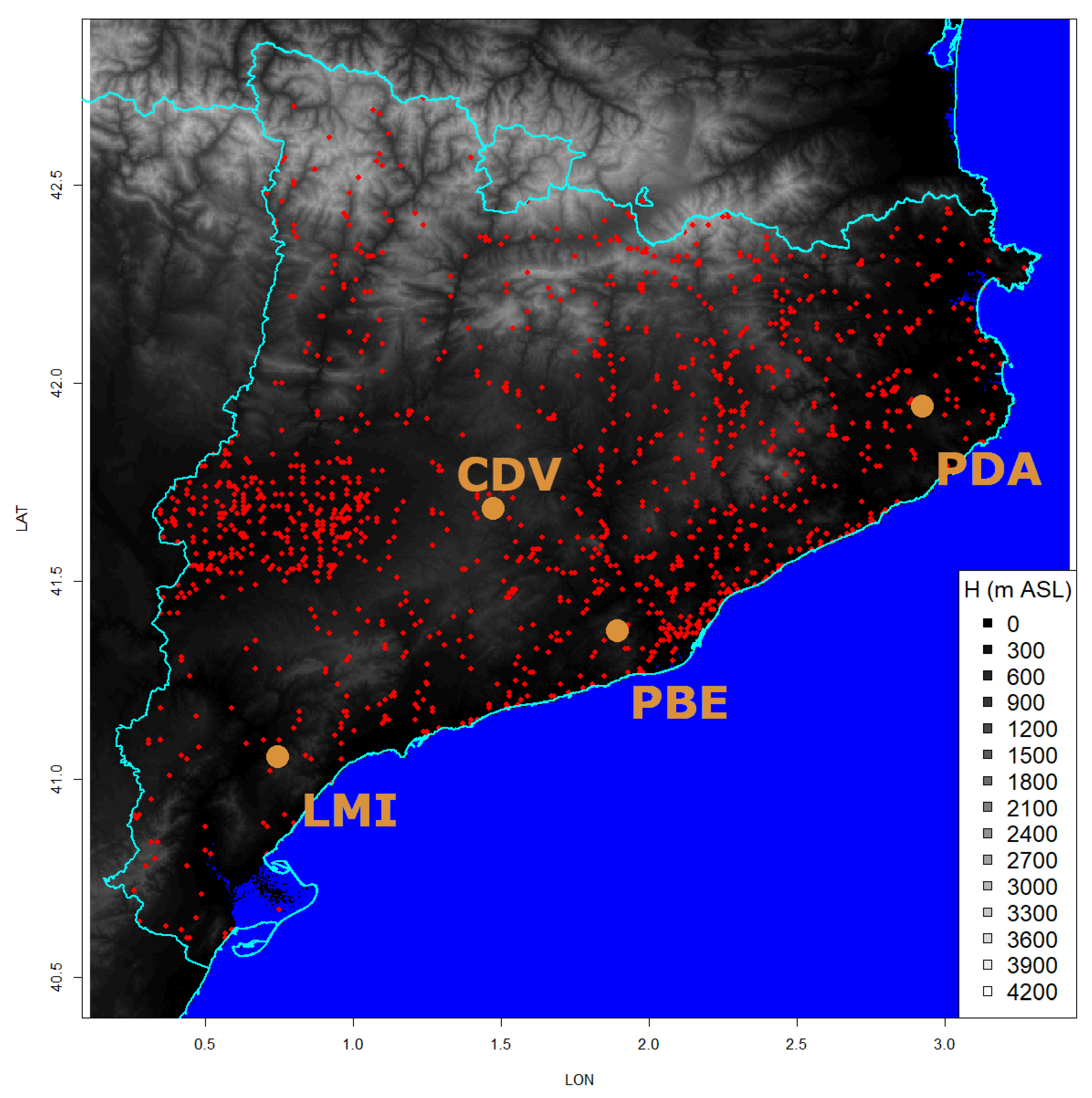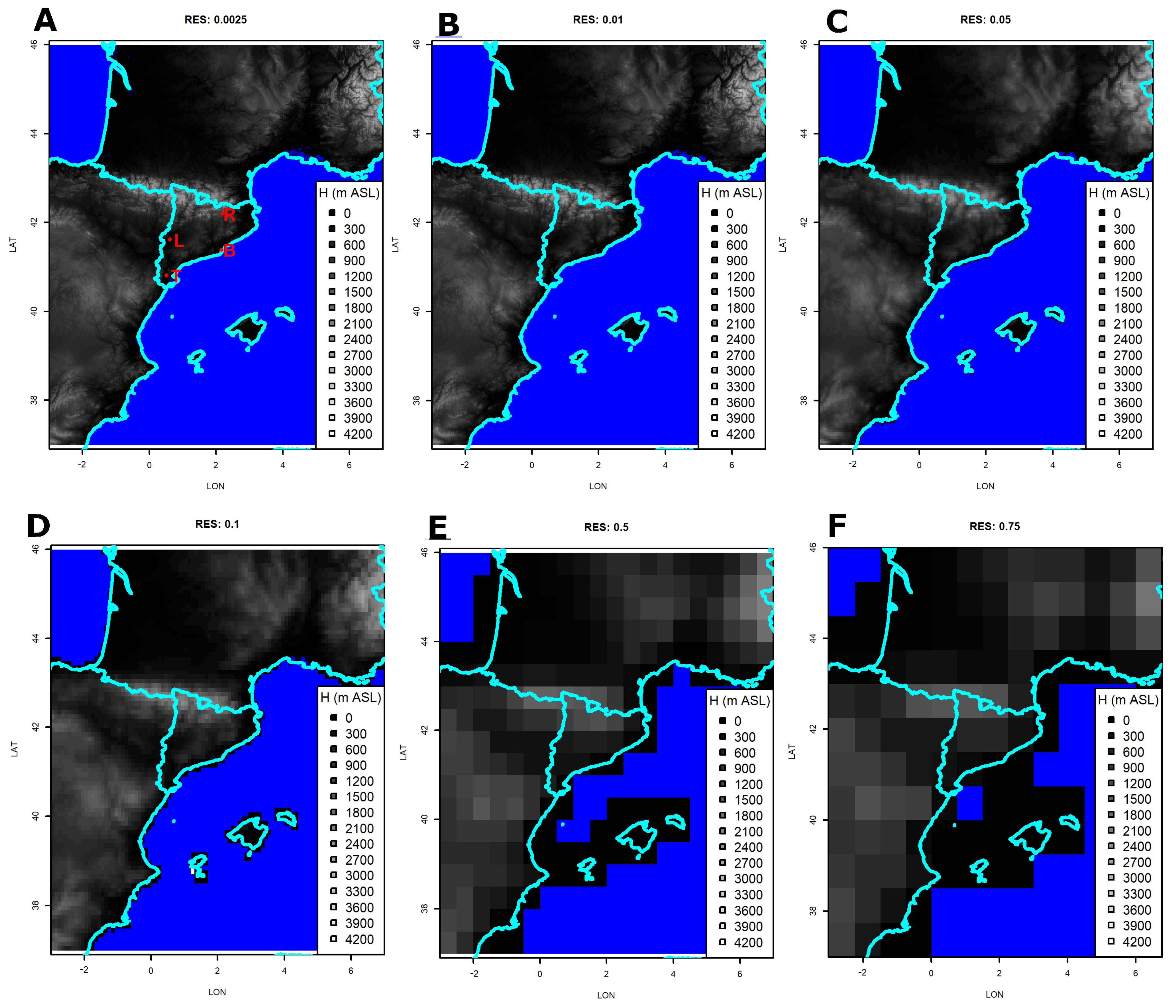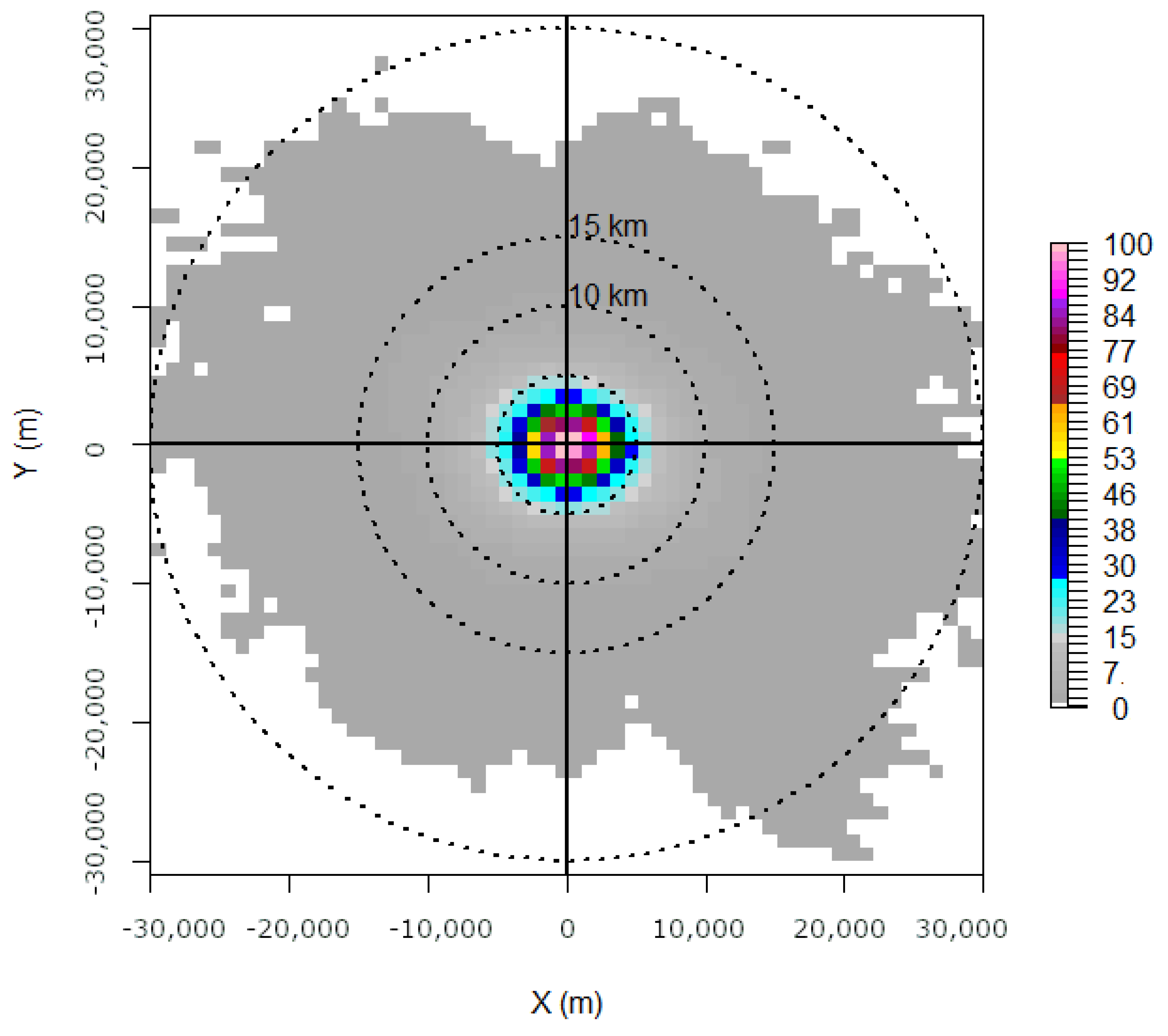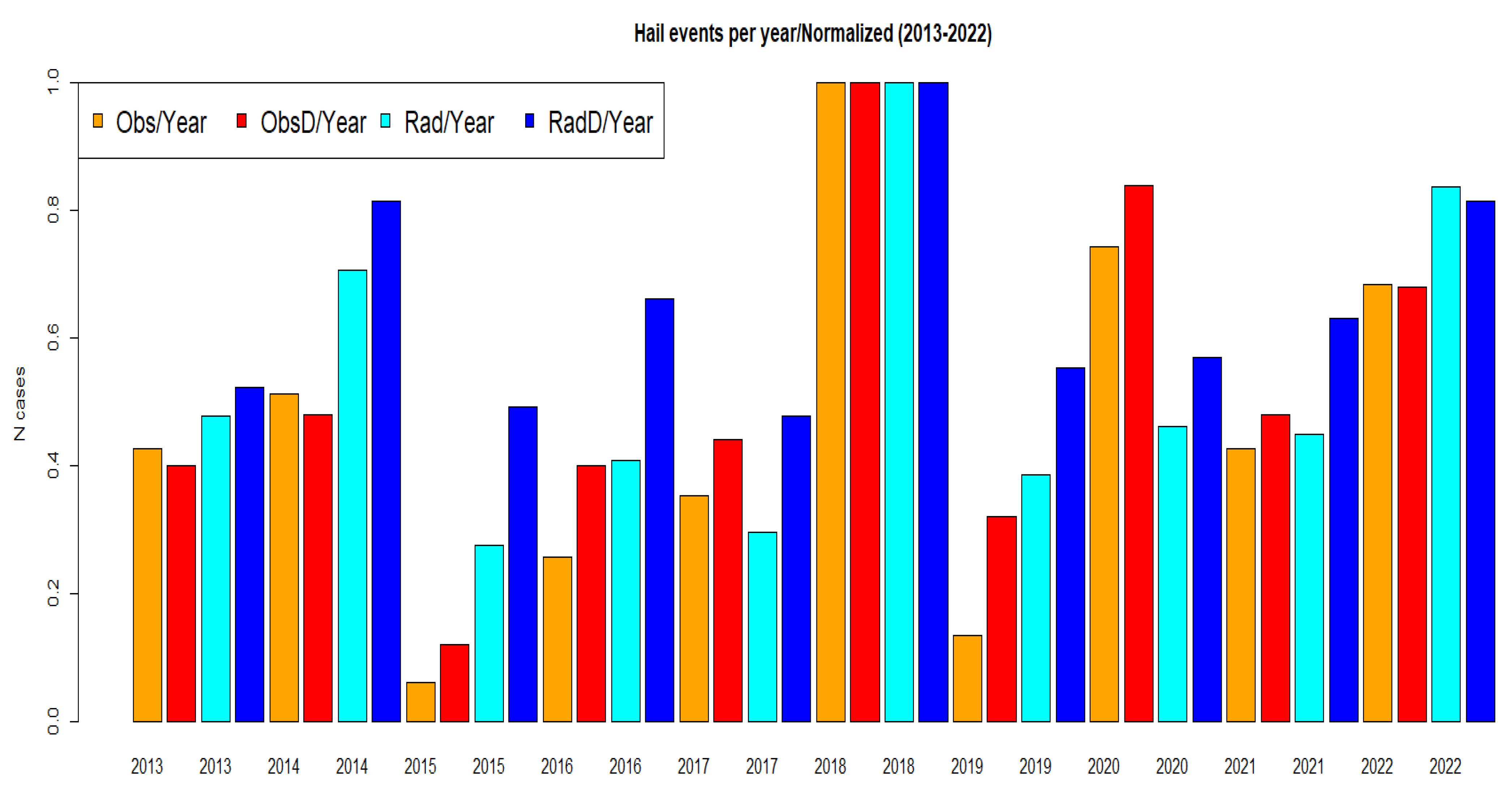The Variability of Hailfall in Catalonia and Its Climatic Implications
Abstract
:1. Introduction
2. Materials and Methods
2.1. Topography
2.2. Ground Observations
2.3. Weather Radar
2.4. Methodology
3. Results
3.1. Topography
3.2. Ground Observations
3.3. Weather Radar
3.4. Trend
4. Discussion and Conclusions
Author Contributions
Funding
Data Availability Statement
Acknowledgments
Conflicts of Interest
References
- Allen, J.T. Climate Change and Severe Thunderstorms. In Oxford Research Encyclopedia of Climate Science; Invited Review Paper; Harold Brooks: Riverside, CA, USA, 2018; 67p. [Google Scholar] [CrossRef]
- Baker, A.R. Hail as hazard: Changing attitudes to crop protection against hail damage in France, 1815–1914. Agric. Hist. Rev. 2012, 60, 19–36. [Google Scholar]
- Mohr, S.; Kunz, M.; Keuler, K. Development and application of a logistic model to estimate the past and future hail potential in Germany. J. Geophys. Res. Atmos. 2015, 120, 3939–3956. [Google Scholar] [CrossRef]
- Kapsch, M.L.; Kunz, M.; Vitolo, R.; Economou, T. Long-term trends of hail-related weather types in an ensemble of regional climate models using a Bayesian approach. J. Geophys. Res. Atmos. 2012, 117. [Google Scholar] [CrossRef] [Green Version]
- Púčik, T.; Groenemeijer, P.; Rädler, A.T.; Tijssen, L.; Nikulin, G.; Prein, A.F.; Van Meijgaard, E.; Fealy, R.; Jacob, D.; Teichmann, C. Future changes in European severe convection environments in a regional climate model ensemble. J. Clim. 2017, 30, 6771–6794. [Google Scholar] [CrossRef] [Green Version]
- Taszarek, M.; Allen, J.T.; Brooks, H.E.; Pilguj, N.; Czernecki, B. Differing trends in United States and European severe thunderstorm environments in a warming climate. Bull. Am. Meteorol. Soc. 2021, 102, E296–E322. [Google Scholar] [CrossRef]
- Brimelow, J.C.; Burrows, W.R.; Hanesiak, J.M. The changing hail threat over North America in response to anthropogenic climate change. Nat. Clim. Chang. 2017, 7, 516–522. [Google Scholar] [CrossRef]
- Pilguj, N.; Taszarek, M.; Allen, J.T.; Hoogewind, K.A. Are trends in convective parameters over the United States and Europe consistent between reanalyses and observations? J. Clim. 2022, 35, 3605–3626. [Google Scholar] [CrossRef]
- Trapp, R.J.; Hoogewind, K.A.; Lasher-Trapp, S. Future changes in hail occurrence in the United States determined through convection-permitting dynamical downscaling. J. Clim. 2019, 32, 5493–5509. [Google Scholar] [CrossRef]
- Raupach, T.H.; Martius, O.; Allen, J.T.; Kunz, M.; Lasher-Trapp, S.; Mohr, S.; Rasmussen, K.L.; Trapp, R.J.; Zhang, Q. The effects of climate change on hailstorms. Nat. Rev. Earth Environ. 2021, 2, 213–226. [Google Scholar] [CrossRef]
- Taszarek, M.; Brooks, H.E.; Czernecki, B.; Szuster, P.; Fortuniak, K. Climatological aspects of convective parameters over Europe: A comparison of ERA-Interim and sounding data. J. Clim. 2018, 31, 4281–4308. [Google Scholar] [CrossRef]
- Aran, M.; Pena, J.; Torà, M. Atmospheric circulation patterns associated with hail events in Lleida (Catalonia). Atmos. Res. 2011, 100, 428–438. [Google Scholar] [CrossRef]
- Sanchez, J.L.; Merino, A.; Melcón, P.; García-Ortega, E.; Fernández-González, S.; Berthet, C.; Dessens, J. Are meteorological conditions favoring hail precipitation change in Southern Europe? Analysis of the period 1948–2015. Atmos. Res. 2017, 198, 1–10. [Google Scholar] [CrossRef]
- Berthet, C.; Dessens, J.; Sánchez, J.L. Regional and yearly variations of hail frequency and intensity in France. Atmos. Res. 2011, 100, 391–400. [Google Scholar] [CrossRef]
- Walsh, K.; White, C.J.; McInnes, K.; Holmes, J.; Schuster, S.; Richter, H.; Evans, J.P.; Di Luca, A.; Warren, R.A. Natural hazards in Australia: Storms, wind and hail. Clim. Chang. 2016, 139, 55–67. [Google Scholar] [CrossRef] [Green Version]
- Childs, S.J.; Schumacher, R.S.; Strader, S.M. Projecting end-of-century human exposure from tornadoes and severe hailstorms in eastern Colorado: Meteorological and population perspectives. Weather. Clim. Soc. 2020, 12, 575–595. [Google Scholar] [CrossRef]
- Laviola, S.; Monte, G.; Cattani, E.; Levizzani, V. Hail Climatology in the Mediterranean Basin Using the GPM Constellation (1999–2021). Remote Sens. 2022, 14, 4320. [Google Scholar] [CrossRef]
- Merino, A.; Sánchez, J.L.; Fernández-González, S.; García-Ortega, E.; Marcos, J.L.; Berthet, C.; Dessens, J. Hailfalls in southwest Europe: EOF analysis for identifying synoptic pattern and their trends. Atmos. Res. 2019, 215, 42–56. [Google Scholar] [CrossRef]
- Punge, H.J.; Bedka, K.M.; Kunz, M.; Reinbold, A. Hail frequency estimation across Europe based on a combination of overshooting top detections and the ERA-INTERIM reanalysis. Atmos. Res. 2017, 198, 34–43. [Google Scholar] [CrossRef]
- Cintineo, J.L.; Smith, T.M.; Lakshmanan, V.; Brooks, H.E.; Ortega, K.L. An objective high-resolution hail climatology of the contiguous United States. Weather Forecast. 2012, 27, 1235–1248. [Google Scholar] [CrossRef] [Green Version]
- Junghänel, T.; Brendel, C.; Winterrath, T.; Walter, A. Towards a radar-and observation-based hail climatology for Germany. Meteorol. Z. 2016, 25, 435–445. [Google Scholar] [CrossRef]
- Lukach, M.; Foresti, L.; Giot, O.; Delobbe, L. Estimating the occurrence and severity of hail based on 10 years of observations from weather radar in Belgium. Meteorol. Appl. 2017, 24, 250–259. [Google Scholar] [CrossRef] [Green Version]
- Warren, R.A.; Ramsay, H.A.; Siems, S.T.; Manton, M.J.; Peter, J.R.; Protat, A.; Pillalamarri, A. Radar-based climatology of damaging hailstorms in Brisbane and Sydney, Australia. Q. J. R. Meteorol. Soc. 2020, 146, 505–530. [Google Scholar] [CrossRef]
- Farnell, C.; Rigo, T.; Pineda, N. Lightning jump as a nowcast predictor: Application to severe weather events in Catalonia. Atmos. Res. 2017, 183, 130–141. [Google Scholar] [CrossRef]
- Farnell, C.; Rigo, T.; Pineda, N. Exploring radar and lightning variables associated with the Lightning Jump. Can we predict the size of the hail? Atmos. Res. 2018, 202, 175–186. [Google Scholar] [CrossRef]
- Rigo, T.; Farnell, C. Using maximum Vertical Integrated Liquid (VIL) maps for identifying hail-affected areas: An operative application for agricultural purposes. J. Mediterranean. Meteorol. Climatol. 2019, 16, 15–24. [Google Scholar] [CrossRef]
- Rigo, T.; Llasat, M.C.; Esbrí, L. The Results of Applying Different Methodologies to 10 Years of Quantitative Precipitation Estimation in Catalonia Using Weather Radar. Geomatics 2021, 1, 347–368. [Google Scholar] [CrossRef]
- del Moral, A.; del Carmen Llasat, M.; Rigo, T. Connecting flash flood events with radar-derived convective storm characteristics on the northwestern Mediterranean coast: Knowing the present for better future scenarios adaptation. Atmos. Res. 2020, 238, 104863. [Google Scholar] [CrossRef]
- Aran, M.; Sairouni, A.; Bech, J.; Toda, J.; Rigo, T.; Cunillera, J.; Moré, J. Pilot project for intensive surveillance of hail events in Terres de Ponent (Lleida). Atmos. Res. 2007, 83, 315–335. [Google Scholar] [CrossRef]










| Resolution → | 0.0025° | 0.01° | 0.05° | 0.1° | 0.5° | 0.75° |
|---|---|---|---|---|---|---|
| Location ↓ | ||||||
| Barcelona | 42.0 | 34.3 | 28.0 | 43.9 | 33.0 | 86.8 |
| Ripoll | 778.0 | 808.1 | 852.2 | 863.5 | 1190.3 | 686.0 |
| Lleida | 209.0 | 174.4 | 168.1 | 194.9 | 405.7 | 454.0 |
| Tortosa | 13.0 | 6.9 | 60.8 | 220.5 | 86.1 | 321.2 |
| Max | Nobs | 0.0025 | 0.01 | 0.05 | 0.1 | 0.5 | 0.75 | ||||||
|---|---|---|---|---|---|---|---|---|---|---|---|---|---|
| Bcn | NA | NA | 1.0 | 4 | 1.5 | 17 | 2.0 | 29 | 3.5 | 164 | 6.0 | 471 | |
| Rip | NA | NA | 0.8 | 1 | 2.0 | 2 | 2.5 | 4 | 6.0 | 229 | 5.0 | 193 | |
| Lle | NA | NA | 3.0 | 10 | 3.0 | 20 | 3.0 | 34 | 4.0 | 313 | 6.0 | 547 | |
| Tor | NA | NA | 2.5 | 5 | 2.5 | 5 | 2.5 | 6 | 4.0 | 23 | 4.0 | 59 | |
Disclaimer/Publisher’s Note: The statements, opinions and data contained in all publications are solely those of the individual author(s) and contributor(s) and not of MDPI and/or the editor(s). MDPI and/or the editor(s) disclaim responsibility for any injury to people or property resulting from any ideas, methods, instructions or products referred to in the content. |
© 2023 by the authors. Licensee MDPI, Basel, Switzerland. This article is an open access article distributed under the terms and conditions of the Creative Commons Attribution (CC BY) license (https://creativecommons.org/licenses/by/4.0/).
Share and Cite
Rigo, T.; Farnell, C. The Variability of Hailfall in Catalonia and Its Climatic Implications. Climate 2023, 11, 16. https://doi.org/10.3390/cli11010016
Rigo T, Farnell C. The Variability of Hailfall in Catalonia and Its Climatic Implications. Climate. 2023; 11(1):16. https://doi.org/10.3390/cli11010016
Chicago/Turabian StyleRigo, Tomeu, and Carme Farnell. 2023. "The Variability of Hailfall in Catalonia and Its Climatic Implications" Climate 11, no. 1: 16. https://doi.org/10.3390/cli11010016






